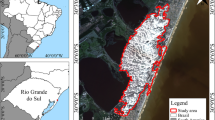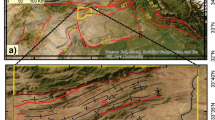Abstract
This study is aimed at using the Empirical Line Method (ELM) to eliminate atmospheric effects with respect to visible and near infrared bands of advanced spaceborne thermal emission and reflection radiometer (ASTER) and enhanced thematic mapper plus (ETM+) data. Two targets (Amran limestone as light target and quartz-biotite-sericite-graphite schists as dark target), which were widely exposed and easy to identify in the imagery were selected. The accuracy of the atmospheric correction method was evaluated from three targets (vegetation cover, Amran limestone and Akbra shale) of the surface reflectance. Analytical spectral devices (ASD) FieldSpec3 was used to measure the spectra of target samples. ETM+ data were less influenced by the atmospheric effect when compared to ASTER data. Normalized differences vegetation indices (NDVI) displayed good results with reflectance data when compared with digital number (DN) data because it is highly sensitive to ground truth reflectance (GTR). Most of the differences observed before and after calibration of satellite images (ASTER and ETM+) were absorbed in the SWIR region.
Similar content being viewed by others
References
Wang Peijuan, Liu Suhong, Zhu Qijiang, et al. (2004) The study of method in monitoring mineral environment with remote sensing technology[C]. Geoscience and Remote Sensing Symposium. IGARSS, apos; 04
Baugh W M, Groeneveld D P (2008) Empirical proof of the empirical line [J]. International Journal of Remote Sensing, 29(3): 665–672
Mather P M (2004) Computer processing of remotely-sensed images: an introduction [M]. Chicheste: John Wiley & Sons.
Song C, Woodcock C E, Seto K C, et al. (2001) Classification and change detection using Landsat TM data: when and how to correct atmospheric effects?[M]. Remote Sensing of Environment, 75(2): 230–244
Jensen J R (2005) Introductory digital image processing: a remote sensing prospective [M]. New Jersey: Prentice Hall Series in Geographic Information Science
Green A A, Huntington J F (1989) Remote sensing for surface mineralogy[C]. Proceedings of Exploration’87: 3rd Decennial International Conference on Geophysical and Geochemical Exploration for Minerals and Groundwater, Toronto
Karpouzli E, Malthus T (2003) The empirical line method for the atmospheric correction of IKONOS imagery [J]. International Journal of Remote Sensing, 24(5): 1 143–1 150
Smith G M, Milton E J (1999) The use of the empirical line method to calibrate remotely sensed data to reflectance [J]. International Journal of Remote Sensing, 20(13): 2 653–2 662
Clark R N, Swayze G A, Livo K E, et al.(2002) Surface reflectance calibration of terrestrial imaging spectroscopy data: a tutorial using AVIRIS[C]. Proceedings of the 10th Airborn Earth Science Workshop, Nevada
Conel J E, Green R O, Vane G, et al. (1987) Airborne imaging spectrometer-2: radiometric spectral characteristics and comparison of ways to compensate for atmosphere [C]. Proceedings of SPIE
Roberts D A, Yamaguchi Y, Lyon R J P (1986) Comparison of various techniques for calibration of AIS data[M]. JPL publication 86-35. Pasadena, CA: Jet Propulsion Laboratory
Ballew G I (1975) A method for converting Landsat-1 MSS data to reflectance by means of ground calibration sites[R]. Stanford RSL Technical Report 75-5, California, Stanford University
Author information
Authors and Affiliations
Corresponding author
About this article
Cite this article
Qaid, A.M., Basavarajappa, H.T., Rajendran, S. et al. Calibration of ASTER and ETM + imagery using empirical line method—A case study of north-east of Hajjah, Yemen. Geo-spat. Inf. Sci. 12, 197–201 (2009). https://doi.org/10.1007/s11806-009-0052-0
Received:
Published:
Issue Date:
DOI: https://doi.org/10.1007/s11806-009-0052-0




